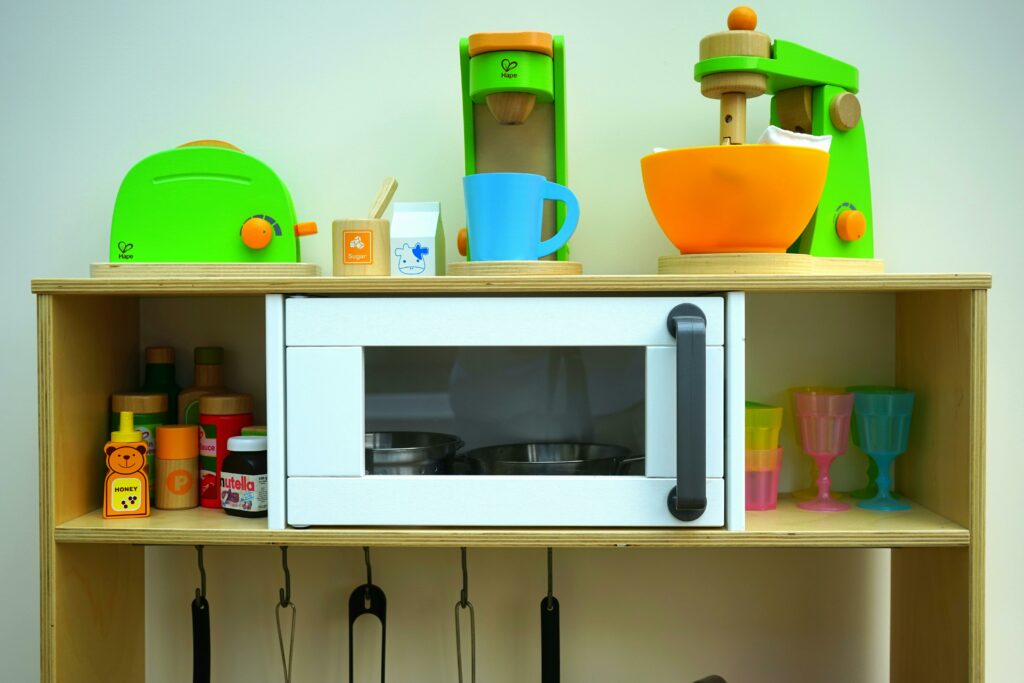
Everyone has most likely experienced throwing in a pre-made dinner container in the microwave excited to gulf down the easy-to-make dish. When taking out the container maybe you’ve noticed some dents from overheating the food. Oops! You gulf down your food anyway. But what are the repercussions of warming plastic to our health. Are microwaves safe at all. This article will address how to use a microwave safely.
What Does a Microwave Do?
Microwaves have a magnetron in it that uses electromagnetic waves (microwaves) to move rapidly causing the water molecule in food to rock back and forth. This friction of molecules increases heat on the surface of the food. Food is, therefore, not cooked from the inside out. Food is exteriorly heated and then that conduction of heat increases the internal temperature. Microwaves reflect off metal but pass through glass, plastic, paper and other similar materials, only being absorbed by the food.
Do Microwaves Emit Radiation like in X rays that can alter DNA?
X Rays use ionizing radiation while microwaves use non-ionizing radiation. The microwave radiation comes from electrical and magnetic waves moving in space together, like waves from a radio. Non-ionizing radiation doesn’t have the power to alter DNA by knocking electrons out of atoms but ionizing radiation seen in X Rays do have this capability. It’s important to have a microwave in good condition as a microwave in good condition typically won’t have radiation leaking from it. However any damage to a microwave can increase the risk. Warming food in microwaves does not cause radiation contamination in the food.
Are Nutrients Removed by Microwaves
Microwaves rely on the water content in the food to vibrate the molecules and create heat. When foods, like vegetables, have higher levels of water they tend to heat up quicker. Compared to conventional methods of cooking, warming up food in a microwave can actually preserve vitamins and minerals. Shorter cooking times and the absence of very high temperature water can reduce nutrient loss.
Plastic and Microwaves
Although microwaves trigger heat in food, the heat from the food can warm the containers that they are in. This becomes an issue when using plastic containers containing BPA or phthalates. BPA and phthalates have both been seen to be hormone disruptors (interfere with body’s hormonal system) and have the ability to leak from plastic in microwaves. Phthalates are added plasticizers and make plastic flexible. Typically found in plastic water bottles, to-go containers, etc.
Phthalates aren’t chemically bonded to plastic so they can easily seep out of plastics and into food in low and high temperatures. Phthalates were even seen to seep into food at 4C temp however the amount of phthalate migration does increase with increased temperature and the duration of food in the container. Old containers also have been seen to emit more phthalates due to continual polymer breakdown and small deformations to the container.
Phthalates have been seen to cause
Developmental Issues:
- ADHD
- Autism in fetal exposure
- and cognitive delay
reproductive problems:
- It can mimic hormones or block natural effects of hormones. This can cause menstrual irregularities and early development of breast in females. Also can cause low sperm count or abnormal reproductive development in males.
- Children and infants are often the most vulnerable.
BPA (bisphenol A) also found in receipts have been seen to leak onto food as well when used in containers. BPA helps make the container shatter resistant, makes the product lightweight and acts as a heat protectant. BPA, like phthalates, are seen to leak onto foods especially when exposed to higher temperatures. BPA has been seen in several body fluids when testing. It can be absorbed and passed from oral/dermal routes, inhalation, breastfeeding, and placental transfer. BPA has been seen to affect the endocrine, immune and reproductive systems to name a few. Due to its toxic nature, it has been banned from feeding bottles in many countries. BPA found in polycarbonate containers was found to migrate onto food by 3x when warmed up to 100 degrees Celsius for 9 mins compared to the barely detectable numbers when left at room temperature.
BPA can be found in plastic coverings, kitchenware, in containers with direct contact to food, inner linings in cans, jar caps, dental materials, toys etc. It’s metabolized in the liver and excreted through our urine.
BPA has been seen to play a role in male and female infertility, breast and prostate cancer, PCOS and other hormone driven conditions. It can interact “with estrogen receptors and act as an agonist or antagonist via estrogen receptor dependent signaling pathways”.
Conclusion
In conclusion, it’s no secret that BPA and phthalates should be avoided if possible but it’s astounding to track all the ways these elements can seep into our foods and our bodies and the damage they can do once inside. Best practice is to avoid warming or even storing food in plastics containing phthalates and BPA. Try instead to use glass containers however, avoid warming food with plastic lids as well, as the condensation can heat up the plastic causing possible seeping of toxic elements into the food. Based on current studies and FDA guidance, microwaves can be a fairly safe and convenient way to warm up food but please be aware of the manner in which it’s done. Toxic chemicals are all around us and trying to fight them off can seem overwhelming. However, as people are becoming educated and demanding safer products, manufacturers are listening. Providing healthier lifestyles for you and your family starts with steps like these.
Make sure to throw out old plastic containers and really think about shifting to glass containers. Watch how long you warm or cook your foods to avoid excessive loss of nutrients.
Avoid plastic covers even on your glassware when cooking (typically will state not to microwave)
Eventually avoid excessive can use and other products that are high in these elements.





You must be logged in to post a comment.